Dwight Eisenhower - Artist
(Among Other Things)
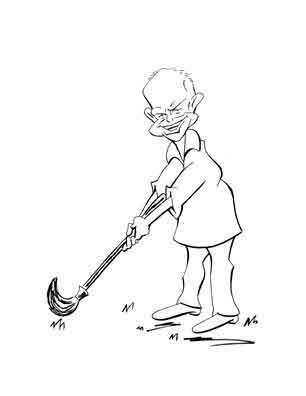
Dwight Eisenhower
Artist
Baby boomers will remember Ike - that is, David Dwight Eisenhower (yes, it's David Dwight Eisenhower). Probably he is the first president they remember although those at the upper end of the baby boomer age scale may remember Harry Truman.
Ike was born in October 14, 1890, in Denison, Texas, and grew up in Abilene, Kansas. The later inversion of his double-D name came from the fact that his dad was also named David and to avoid confusion his mom took to calling him by his middle name. But during his senior year in high school we find him listed with David coming first. It was as a kid, though, that he picked up his "Ike" nickname.
Ike (and some biographers) told of his time in Kansas as the quintessential boyhood expected of poor but wholesome and hardworking All-American stock. The truth is his was not quite an Ozzie-and-Harriet-Nelson family of the Great Plains and why he was born in Denison, not Abilene, is not always explained in some biographies. Still, Ike applied himself to his schoolwork, and after working for a couple of years after high school, he requested and received an appointment to West Point. Second Lieutenant Eisenhower graduated in the middle of his class in 1915, and unlike a young officer who had graduated twelve years before (named Douglas MacArthur), Ike received his fair share of demerits. After West Point, Ike soon married Mamie Doud and we read that he would not sit down on his wedding day for fear of creasing his trousers.
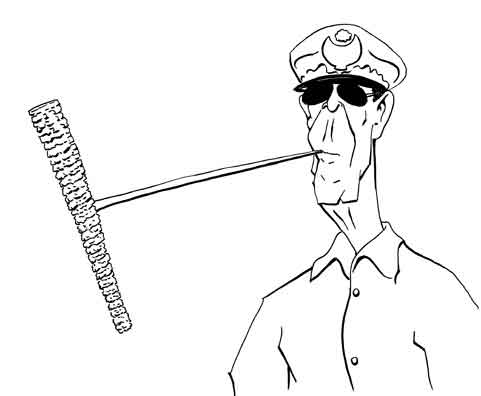
Douglas MacArthur
No Demerits
Ike, despite his repeated requests for overseas duty, did not see action in World War I. Still he must have impressed someone since by 1941, he was a brigadier general. This, though, was a temporary rank for an army which had been gearing up for war - a war that did indeed come three months after his promotion. His "permanent" rank - that is his rank in the US Regular Army - throughout World War II was that of lieutenant colonel. Although temporary ranks trumped permanent ranks for the duration, strictly speaking Ike was lower in the chain of command than a number of his fellow officers, including General George Patton (who had been a bird colonel). This was something that George liked to razz Ike about.
Well, we know what happened. Ike continued to impress his superiors and eventually that meant George C. Marshall, the army chief of staff. George appointed Ike to be the commander of the American forces in Europe, and later Ike became the Supreme Commander of all Allied Forces in Europe. Of course, after the war he was promoted to General of the Army (Five-Star) of the Regular Army - edging out George Patton.
After the war Ike served for a short time as president of Columbia University and then (also briefly) as NATO commander. But he also was thinking about a longer term job, and once Ike had commented to then-president Harry Truman that he was pondering a political career. Harry cheerfully told Ike that he was making a rough choice and he should expect to be assailed from all sides by the opposition. Harry proved this was indeed the case when Ike ran on the Republican ticket. It was Harry's merciless - and some thought irrational - trashing of Ike that may have led to the defeat of Democratic candidate and all around nice guy Adlai Stevenson.
With his catchy "I Like Ike" slogan - Dwight won handily not just once, but twice. He was sworn in on January 20, 1953 being the 34th President of the United States and the 33rd man to take the office (the solution to this conundrum is, as the mathematical texts say, left to the reader). He served two full terms and as a president he was - increasingly unusual by today's standards - held in high esteem by much of the public.
Perhaps it was Ike's popularity - not to mention his ordinary looks and Midwestern speech - that gave him one distinction that presidents who came after have not enjoyed. Ike was the one president elected after the mid-20th century who was not the subject of comic impressionists. Imitating the president for comedic effect actually began with Calvin Coolidge but this entertainment genre really didn't take off until Vaughn Meader's "First Family" album satirized John Kennedy et. al. in 1962. But Ike was spared the impersonators although now you can find the occasional Ike "reenactor".

Harry Truman
Helping Ike Win
Ike brought something of a middle class air to the White House. Among his ways to relax was reading Zane Grey novels (his successor, John Kennedy, preferred the James Bond stories of Ian Fleming) and watching the new medium of television. But most of all he liked to play golf.
Today it's popular to trash presidents if they play a couple of rounds of golf a month. Ike, on the other hand, averaged 100 rounds a year - about two rounds a week - over his two terms. With about a stroke a hole handicap, Ike has been ranked as the #3 best presidential golfer behind John Kennedy (who averaged 80) and Gerald Ford (a powerful driver but a bit erratic). The truth is virtually every president in over a hundred years has played the game, some not too bad, others less so. It's a surprise, but it was Woodrow Wilson who spent the most time on the links, with a total of 1200 rounds over his two terms and rarely breaking 100.
Ike retired to his farm in Gettysburg, Pennsylvania where he continued to play golf but also took up painting. His paintings are not bad and his portrait of amateur golfer Bobby Jones (yes, Bobby Jones, one of the greatest golfers of all time, never turned pro) shows considerable skill. We should remember that in Ike's time at West Point, cadets were required to take classes in drawing and drafting and some of the art by famous military leaders - including William Tecumseh Sherman and Ulysses S Grant - are evident of the rigor of the West Point academic training.
Ike had the good fortune of presiding over times of increasing prosperity which often makes for boring reading and in later years some malcontents would refer to Ike as a "do-nothing" president. Well, admittedly the 1950's were a bit of an anti-climax compared to the years from the 1920's through the 1940's. But there was still quite a bit going on in the world. Certainly as has every president, Ike left his legacies.
And these are?
Well the 1950's were the times where we changed from the Good Old Days (which sometimes stunk) to Modern Times. And among what we got from Ike's Time of Transition and in no particular order are:
Interstate Highways and International Motorways
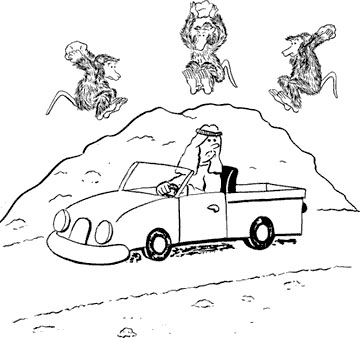
Interstate Highways
The hazards are a bit different.
Yes, Ike was responsible more than anyone else for getting into a car and making a trip in a few hours that used to take days. He pushed for the building the federally financed US Interstate System which in turn served as the model for the other controlled-access freeways throughout the world. Ike, as a military man, moved his family frequently and was well aware of the tedium of road travel in the United States.
Now it is true that the Autobahn in Germany, although not yet given the name, was constructed in the 1930's. The German four lane limited access freeways were the first in the world. It is likely that during Ike's time overseas and his visits to Germany that gave him the idea that such roads would be well-suited for the US. And after the US began putting in its interstates that the world ended up with the Autoroute in France and the A1(M) motorways in England with their Welcome Breaks. And of course most other countries have their own names for their highway systems. But a freeway in Jiddah, Saudi Arabia looks pretty much the same as a freeway near Rataan, Oklahoma. Of course the hazards on highways near Jiddah can differ a bit from those in Rattan.
The availability of faster roads paved the way (no joke intended) for the Rise of the Automobile and it was during the 1950's that owning a car in the US became the norm. This in turn led to people being able to live miles from where they worked. So by the end of the 50's we had congestion and rush-hour traffic jams. But after a decade or so, the trend of living far from work began to reverse and led to the flight from and the decline of the center cities. Hence the rise of modern suburbia's corporate campus, urban sprawl, and the indoor mall, the latter phenomenon now also on its way out.
The Youth Culture
Believe it or not, there was once a time when parents decided what to do for vacation, what careers their kids should (or at least should not) pursue, and what everyone in the family should think. But it was not in the 1970's or even the now legendary (or as some prefer, mythical) 1960's when adults quit calling the shots. No, it was in the 1950's that the kids began taking over.
How did that happen?

Before and After
It all started with Ike.
Well, it was the 1950's that begat the concept of the TEENAGER. Before World War II, you were a kid or you were an adult. Going into the workforce at 14 - even if it was in the family business - had been common and high school was looked on as an affectation for the rich kids. But after World War II there were rising education requirements, and kids finishing high school became de rigeur. The GI Bill also opened up more college doors and college became something that was reachable for even lower income families. Consequently, the ages between 13 and 19 became a time where parents had to put up with their increasingly moody offspring and until the British Invasion of the mid 1960's, adults had to tolerate their sons sporting crew-cuts and driving hot-rods, and their daughter's laying around on the floor in their poodle dresses and bobby socks while playing 45's and blubbering over J. Frank Wilson's "Last Kiss".
The 50's - which culturally lasted until 1964 - was also the Era of the Beatniks. But these cool ladies and gentlemen weren't quite the extraordinary phenomenon as some thought. There have always been counter culture movements. Before the Beats of the 50's were the Hipsters of the 40's. And before the Hipster's there were the Lost Generation of European-transplanted Americans and groups like the Wandervögel in Germany. Shoot, you can go on back even to the ancient Greeks where the counter-culture kids were hanging around with Socrates.
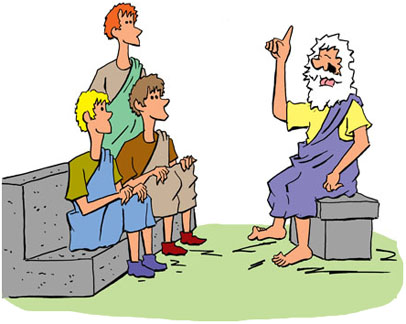
Counter Culture
But it was the Beats who were the direct precursors of the Phenomenon That Terrified America. That is, of course, the Hippies. And as in all counter-culture movements some of what the Hippies wrought caught on and some things didn't. But like it or not, for better or for worse, the Family Values of the Fifties vanished forever.
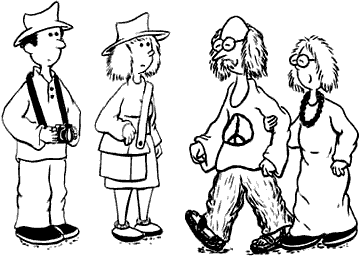
Family Values
The Cold War
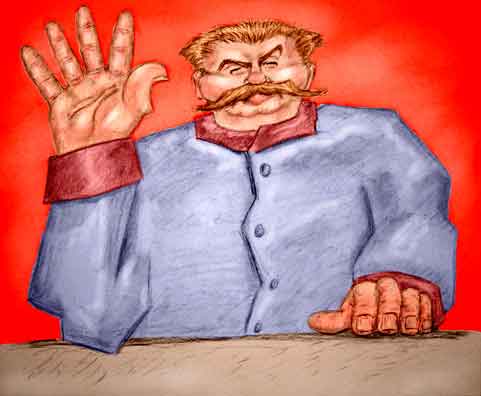
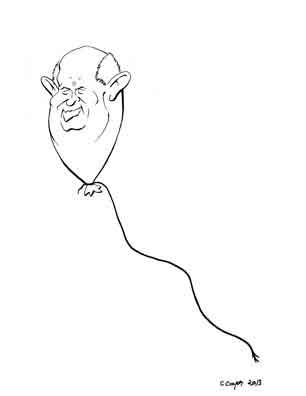
Joe and Nikita
They certainly helped
For those who may be too young to remember it, the Cold War was the time when the United States and the then-extant Soviet Union were not getting along and blaming the other for all the trouble spots in the world. Officially, history tells us the Cold War began immediately after World War II and ended with the collapse of the Soviet Union in 1990. But recent events show us it hasn't totally vanished.
The Cold War really became official when Winston Churchill gave his famous "Iron Curtain" speech on March 5, 1946 at Westminster College in Fulton, Missouri. So although the Cold War escalated during Ike's term, we really can't say he was actually responsible for it.
On the other hand, Uncle Joe Stalin and his onetime acolyte Nikita "We-Will-Bury-You" Khrushchev certainly did their part. Nikita in particular became famous for creating Angst in the West with his fist pounding and hand-waving speeches at the United Nations (the famous "shoe-incident" may or may not have happened) and his prophecy that the grandchildren of West would grow up under communism. An ironic prediction, indeed, since his own son, Sergei, eventually moved to the United States and became a US citizen.
The defining characteristic of the Cold War was the fear of nuclear annihilation. This was the time when people began building fall-out shelters (as if that would help) and kids at schools would go through "atomic attack" drills where they went out and crouched down in the halls (as if that would help). The latter exercises soon led to joke posters that said in case of atomic attack crouch down, place your head between you legs, and kiss your arse good-by. That would help as much as anything.
But the much vaunted nuclear war never happened despite a plethora of atomic-doom movies starting in the late 50's and continuing on past the 1980's - a time by which some popular prophecies had claimed civilization "as we know it" would come to an end. Of course the 80's was also the decade of the computer revolution and so those who like to change definitions after their prophecy fails can say they were right after all
Rockets and Space Flight
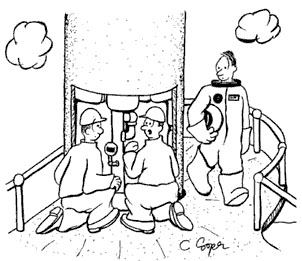
"Don't worry about it. This isn't exactly rocket science, you know."
Although space exploration and rocket flight had been the subject of serious research since the beginning of the 20th century, and physics professor Robert Goddard had been experimenting with liquid fuel rockets on his Aunt Effie's farm since the 1920's, it wasn't until the German rocket scientists in World War II like Werner von Braun surrendered to the Allies (and moved to the United States) that a real program for space exploration began.
The actual goal of going to the moon wasn't set until John Kennedy took office in 1961, but regular sending of rockets into space began during Ike's administration. You'll sometimes read that the first rocket launched by the US to reach outer space was in 1946. However, that rocket - part of the Viking Program - only reached 50 miles. The beginnings of "Outer Space", although a completely arbitrary height, has been set at the nice round 100 kilometers which is 62 miles, 723 feet, and 10 2/3 inches. This height was not reached by manned flight until 1963 with a flight by the X-15 rocket plane.
But it was during Ike's term that the idea of space flight really captured the public's imagination. Of course, the first milestones were achieved by the Russians in 1957 when they put the first functional man-made satellite, Sputnik I, into orbit. The attendant publicity launched (no joke intended) the Space Race, and for years many people (including one famous - quote - "psychic" - unquote) predicted the Russians would be first on the moon. They were wrong of course and the Sixties were almost done before Neil Armstrong and Buzz Aldrin set foot on the lunar surface.
The 1950's were really a fun time for people who liked the idea of space travel. All sorts of Future-of-Space-Flight books appeared complete with artist conceptions of space ships and space stations and what it would look like if you were to land on this or that planet. Some ideas were not bad; others way off. Venus was pictured as a well-watered twin of the earth with lush vegetation from moisture of the continuous cloud cover. It wasn't until later the first space probes revealed the clouds were primarily sulfuric acid and the temperature at the surface was over 800 degrees Fahrenheit. On the other hand the drawings of the earth - quote - "seen from outer space" - were accurate enough even though it wasn't until 1968 and the famous Earth Rise photograph from Apollo 8 that we finally realized we would actually see clouds.
Serious space exploration did influence the plots of science fiction writers, but there was still a lot that we didn't know. It was this combination of facts with speculative ignorance that produced what many fans consider to be the real Golden Age of Science Fiction (and not the 1930's and 40's as you usually hear). In the 50's science fiction writers could still write convincingly about the technology needed to get a rocket off the earth and yet had free reign to keep the astronauts in our own solar system.
Sadly, as we learned more and more and space probes eventually touched down on most landable planets, the favorite science fiction stories like Ray Bradbury's Martian Chronicles became increasingly quaint. So science fiction writers had to extend the settings of their stories to intergalactic space. This in turn required the plots to depart more and more from actual science and rely on fantasy literary devices such as warp drive and teleporters. Otherwise there was no way to explain how a space ship and its crew could boldly go where no man had gone before.
Big Science and Big Technology: The Military-Industrial Complex
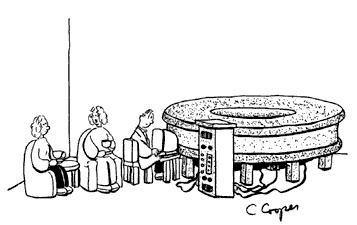
"He just won't leave his work at the office."
It's ironic that Ike, who was a career military officer and Supreme Commander of the Allied Forces in World War II, warned against the rise of the Military-Industrial Complex, particularly since every president following world War II (and including Ike), has furthered that rise.
Of course the rise of Big Science - i. e., scientific research that requires megabucks - began with the Manhattan Project during the Second World War. Most people who know something about the project associate the actual development and testing of the bomb with the relatively small government research site at Alamogordo, New Mexico. But the Manhattan Project was much larger than - as General Leslie Groves put it - a bunch of eggheads chasing a pipe dream. It involved the government working closely with some of the country's largest private industrial firms and was a nationwide effort carried out in many locations throughout the US.
Ike, we must point out, did not say we should not have a military industrial complex. And although in his last speech as president he voiced a number of concerns on the subject, he didn't give any specific solutions other than saying things like we need "to mold, to balance, and to integrate these and other forces, new and old, within the principles of our democratic system". But he did worry that because Big Science and Big Technology required Big Money - most of which would have to come from the government or industry - that we would lose the innovation of the solitary inventor. He also expressed concerns that the need for government and industrial grants would destroy the independence of the universities. Fine sentiments, yes, and today all politicians will voice support for independent scholarship as long as it furthers their own political agenda - or at least the agenda of the people whose votes they solicit.
Today some commentators ask whether Ike's concerns will come true. That's kind of like asking if the printing press will make books more available. Still without Big Science and Big Technology, we would not have the essential ingredients of modern life - E-mail and the Internet, cell phones and other hand held electronic devices, digital music, and round-the-clock availability of television shows and motion pictures.
Hm. Maybe Ike was right.
References
Eisenhower in War and Peace, Jean Edward Smith, Random House, 2012. Delves a bit further into Ike's boyhood and tells us it wasn't quite the Nelson family from Abilene. This also shows us the high school photo where Ike was officially listed using his birth name.
Eisenhower: Soldier and President, Stephen Ambrose, Simon and Schuster, 1990.
Dwight D. Eisenhower, Jean Darby, Lerner, 2003.
"Dwight D. Eisenhower: Golf at the White House", Golf Week, Adam Schupak, November 2, 2009
"Top 10 Golfers-in-Chief", Links Magazine, http://www.linksmagazine.com/best_of_golf/president_golfers/top-10-president-golfers-index/
"Science Fiction in the Fifties: The Real Golden Age", American Science Fiction: Classic Novels of the 1950's, Robert Silverberg", http://www.loa.org/sciencefiction/why_silverberg.jsp